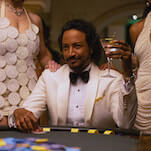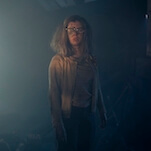On the outskirts of Paris, the body of a Jewish diamond merchant is found in a car parked in the wrong garage. The suspects are a bourgeois insurance salesman, a mysterious Dane with one eye, and the owner of the local filling station, all neighbors at an isolated crossroads. The famed detective Jules Maigret arrives from the city to investigate. He goes to the decrepit mansion that the Dane shares with his sister, a child-like proto-femme fatale with an unplaceable gaze. Alone with her in the first floor den, the middle-aged detective wanders the room with the innocent look of a visiting older relative. His first question: “Do you smoke much?” And then: “Do you often play records?”
Re-visiting it, I’m still struck by how much the first six or so minutes resemble a regular early talkie, this endless parade of characters greeting each other, coming and going, with someone always chewing or reading a newspaper in the background. But then the garage door is opened, revealing the body of Isaac Goldberg, the deceased, whose lifeless eye stares directly into the audience. This is “the moment” for Night At The Crossroads: the rupture point, where it at once introduces the mystery of Goldberg’s murder and relinquishes any claims to a satisfying solution to instead pursue its own obscure meanings. Its only true contemporary is Carl Theodor Dreyer’s Vampyr, made the same year, which similarly disregards convention and point-of-view in favor of a continuity of otherworldliness.
The source material was a novel by Georges Simenon, published as Maigret At The Crossroads in English. Simenon, one of the greatest popular writers of the 20th century, was mindbogglingly prolific: He published over 400 novels during his lifetime, 75 of them featuring his most famous creation, Maigret, a pipe-smoking commissaire of the criminal investigation division of the Paris police. Dozens of actors from around the world have played the character in film and TV over the decades, but Night At The Crossroads marked his screen debut, portrayed by Renoir’s older brother, Pierre Renoir. This version of the character is close to Simeon’s own conception of Maigret as a man who is utterly ordinary in appearance and interests, but with an intuitive relationship to crime.
Unassuming, with a broad face and receding hairline, this Maigret investigates mostly through touch, moving through an environment that is often three parts murk to one part solid matter. Night At The Crossroads is defined by constant experimentation and bleak, fogbound atmosphere. It’s an urtext for everything for the French New Wave to the films of Béla Tarr, who would repay the film’s influence with a Simenon adaptation of his own, 2007’s The Man From London. Parts of it are incredibly dark; it’s one of the few films of its era where the night scenes appear to have been actually shot at night, and it’s not uncommon to see an almost completely black screen marked only by a headlamp reflecting off wet road or the flash of a gunshot. The most famous sequence is the climactic car chase, which is shot largely from the front of one moving car as it tries to catch up with another, careening down a twisting country road.
Missing footage or not (Renoir himself never gave a clear answer), the film is directed to draw viewer attention away from narrative and to the suggestive. The introduction of Else (Winna Winifried)—the sister of the one-eyed Dane and the second most important character after Maigret—happens out-of-focus in the background of shot of a stack of cobweb-covered chairs, which Renoir holds for around thirty seconds before finally moving to the center of the room as she and the detective sit down. Earlier, in the sequence where her brother, Carl (Georges Koudria), undergoes a grueling interrogation at the police headquarters at 36 Quai Des Orfèvres, Renoir marks the passage of time with disorienting cuts to the gutter beside a nearby newsstand, where Parisians are heard buying the morning, afternoon, and evening papers.
It’s one of many moments here that would inspire the New Wave films of Jean-Luc Godard, who championed Night At The Crossroads as “the only great French detective film” during his brief early career as a critic. The internal logic of the film turns the most literal parts of the investigation (Goldberg’s body, the discovery of hidden caches of drugs, questions about the true identity of the Danes, etc.) into hieroglyphs. The code: ambiguously directed glances; Goldberg’s dead stare and Carl’s missing eye; different varieties of smoke; sleep and narcotics; secret compartments, linked to the eerie and eroticized Else. These are clues without a case, meant to create a state of mystery that has nothing to do with crime.
A state like that is perhaps inevitably mystical—especially when the film in question feels like a premonition of the eventual spread of fascism. Renoir, a filmmaker of remarkable social insight, spent the 1930s in apparent anticipation of the nightmare to come, predicting both its nominal conflicts (in Grand Illusion) and the complicity that would enable them (in The Rules Of The Game). Carl, an anti-Semite, is the obvious first suspect in Goldberg’s murder, but as the investigation proceeds, it dredges up xenophobia, envy, and class antagonism.
The crossroads is a non-place, hidden behind drizzle and fog, and by extension a kind of subconscious space, a drab suburb that hides sinister undercurrents and gothic bedrooms, where the surreal can come and go without comment. In this respect, the film could also be called proto-Lynchian. Else plays idly with a jeweled tortoise, a doctor arrives in full opera attire to treat a wounded man, and gangsters who seem to have taken a detour from a completely different type of crime film arrive to open fire from a convertible—moments treated as modulations, like the changes in tone in Renoir’s dramas. Night At The Crossroads’ structure is entirely aesthetic: the camera may trace a puff of smoke drifting away through a room, but good luck figuring out who half of the characters are supposed to be. It finds the essence of something that does not yet exist.


















![HBO teases new Euphoria, Larry David, and much more in 2026 sizzle reel [Updated]](https://img.pastemagazine.com/wp-content/avuploads/2025/12/12100344/MixCollage-12-Dec-2025-09-56-AM-9137.jpg)





















